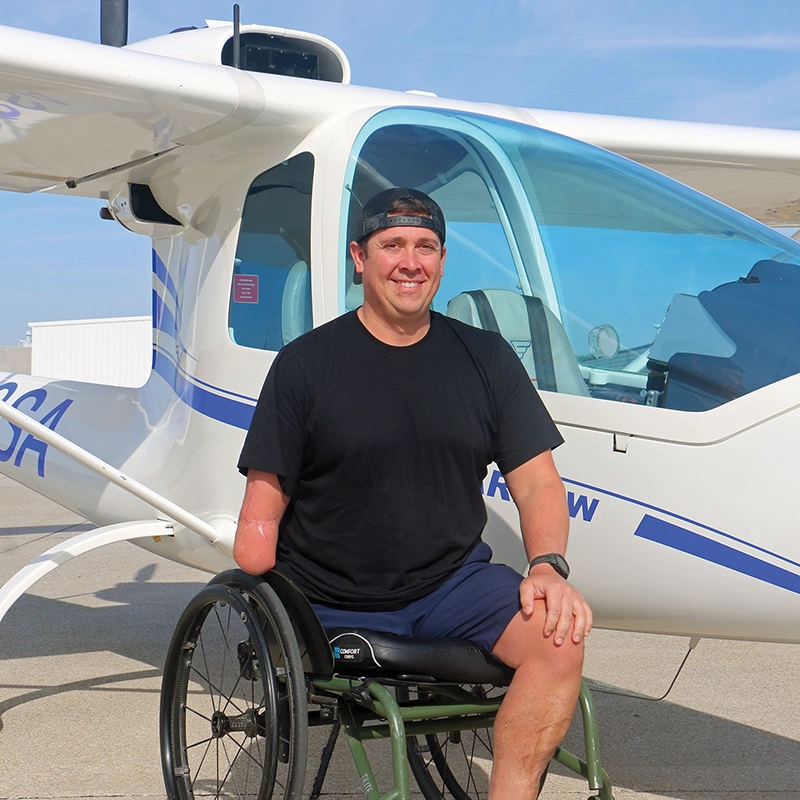
Toe brakes are among the trickiest things for new airplane pilots to master. These finicky components, which slow your roll after landing, are connected to the steering pedals, and they’re highly sensitive to pressure. If you don’t hit them just right, you can end up fishtailing down the runway like a drunk driver.
“But my prosthetic foot is fixed at a 90-degree angle,” says budding aviator Mary Cooper, “so I can’t flex my ankle to get it into the right position. The dashboard hits the top of my prosthesis and won’t let me slide it up. There was some rough braking in the beginning. I had to orchestrate this whole dance to make it work.”
Charles Stites has seen this type of thing happen routinely. “People always find a way,” says Stites, whose nonprofit, Able Flight, has been helping amputees and other people with disabilities learn to fly for nearly 20 years. “They come up with these clever adaptations and creative solutions. That’s one of the wonderfully rewarding things about this program.”
Able Flight is one of two organizations that actively promotes flight training for pilots with disabilities. The other, the Experimental Aircraft Association (EAA), supported Cooper’s education through its Adapt to Fly Scholarship.
“Learning to fly is very empowering,” says Cooper, a serious contender to become the first amputee astronaut someday. “There’s all sorts of good reasons to do it.”
FIVE REASONS TO LEARN TO FLY
ONE: IT’S LIBERATING
“When you leave the earth, your troubles tend to fall away,” says Stites. “You’re in your own little bubble.” Since its founding in 2006, Able Flight has trained nearly 100 adaptive pilots. “When I talk to them about their experience, the word that keeps cropping up is freedom,” Stites says. “Becoming a pilot frees them from the restrictions and boundaries of everyday life.”
TWO: IT BUILDS CONFIDENCE
“I’ve been an amputee my whole life, and I’m pretty good at managing my disability,” Cooper says. “But when you try something new, it reminds you that disability is a skill set. Applying those skills in a way that you’re not used to enhances your comfort level with your disability, and I think that trickles out into other parts of your life.”
THREE: IT’S EMPOWERING
Able Flight instructors allow trainees to devise their own hacks for the cockpit. “We’re the flight experts; they’re the experts in their own lives,” says Stites. He recalls wondering how one recent student, who was missing both limbs on his right side, would manage to operate all the pedals and levers. “I told his instructor, ‘Just let him come up with a solution.’ Sure enough, three days later he’s flying the plane and doing great. He was the second person in that class to do a solo flight.”
FOUR: IT CULTIVATES HEALTHY HABITS OF MIND
Cooper believes flight instills focus and discipline, which can rub off in other parts of your life. “It teaches you risk analysis,” she says. “It teaches you communication. It teaches you to make decisions under uncertainty.” Those are all necessary traits for people with disabilities, Cooper adds, “and the aerospace community benefits from having our perspective. When you design for everyone, you build everything safer.”
FIVE: IT’S NORMALIZING
“By the time someone finishes Able Flight, they don’t see themselves as a pilot with a disability,” says Stites. “They just see themselves as a pilot. They’re flying the airplane by the same rules, with the same respo nsibilities, as every other pilot. They’re held to the same standards. When they’re on the radio, other pilots don’t know they have a disability. It’s really a leveling thing.”
Pilot Scholarships
- Able Flight scholarship applications are due December 31, 2023. Info at ableflight.org/scholarships.
- Adapt to Fly scholarship applications are due March 1, 2024. Info at eaa.org/eaa/learn-to-fly/scholarships.




